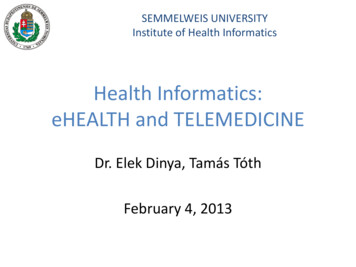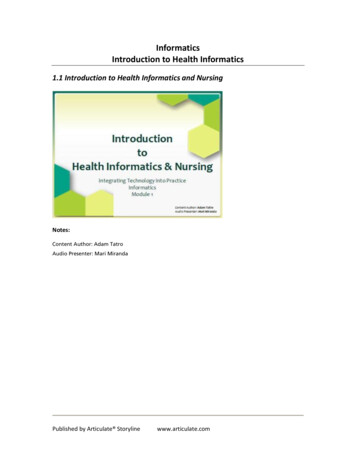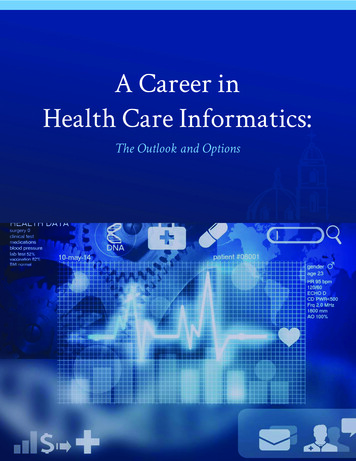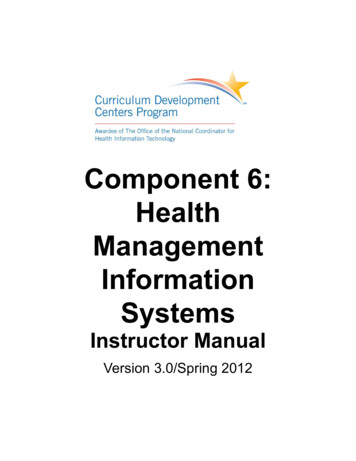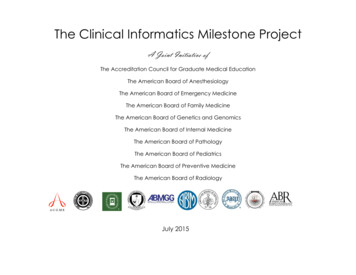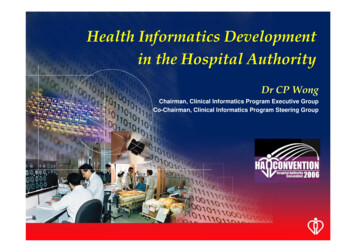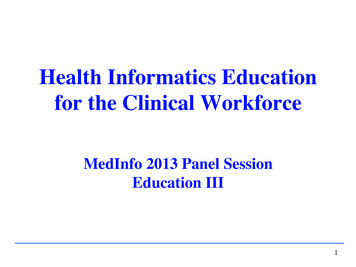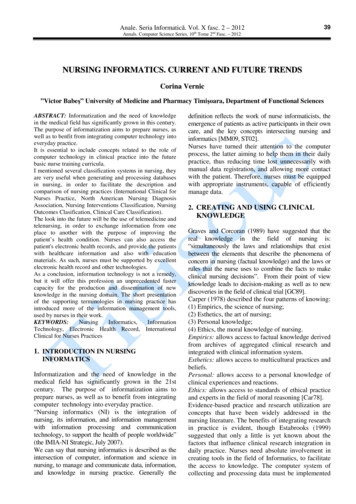
Transcription
Informatics: History, Theory,Concepts and CompetenciesCharlotte Seckman, PhD, RN-BCAssistant Professor, Course DirectorNursing Informatics SpecialistUniversity of Maryland School of Nursing
Objectives Review informatics history, definitions, theoryand concepts as it relates to the healthcareenvironment and role of the professional nurse. Discuss the role of nurses as knowledge workers. Differentiate between computer literacy versusinformation literacy. Compare and contrast the informaticscompetencies for each level of nursing education.
What is Informatics? The term informatics was derived from the Frenchterm informatique, which means to refer to thecomputer milieu (Saba, 2001). Some trace this back to a Russian documentpublished in 1968 Europeans first coined the term in the 1980’s Application to various disciplines
What is Informatics? Information Science Information System InformationTechnology InformationManagement Informatics discipline that studiesinformation processing hardware and software general term forinformation processing withcomputers Process of turning data intoinformation and knowledge combines the study ofinformation processing andcomputers
What is Nursing Informatics?Classic Definition Nursing Informatics is a combination of computerscience, information science and nursing sciencedesigned to assist in the management and processingof nursing data, information, and knowledge tosupport the practice of nursing and the delivery ofnursing care (Graves & Corcoran, 1989). Authors have different definitions and models ofnursing informatics which continue to evolve
Nursing Informatics Defined Scholes and Barber (1980)– “ is the application of computer technology to allfields of nursing - nursing service, nurseeducation, and nursing research” McCormick & Saba (1996)– “Branch of informatics concerned with nurses useof computer technology & management ofinformation that facilitates nursing practice andenhances nursing knowledge.”
Nursing Informatics Defined “ integrates nursing science, computer science,and information science to manage andcommunicate data, information, knowledge andwisdom into nursing practice. facilitates theintegration of data, information, knowledge andwisdom to support patients, nurses, and otherproviders in their decision-making in all roles andsettings. This support is accomplished throughthe use of information structures, informationprocesses, and information technology”(American Nurses Association [ANA] 2007, p. 1).
Nursing Informatics History Florence Nightingale – First Nurse Informatician 1970’s– El Camino Hospital (Mt View, CA), NIH, VA, DOD develop HIS– 1976 - First journal dedicated to medical informatics 1980’s– 1982 - First NI conference at St. Agnes, Baltimore– 1989 - UMSON started first NI program 1990’s– 1991 -Nancy Staggers first PhD in NI– 1992 -American Nurses Association (ANA) recognizes NI specialty– 1994 - ANA Scope & Standards of NI Practice
What’s in a Name?
Informatics Theory, Conceptsand Frameworks
NursingScienceInformaticsGraves and Corcoran (1989)ComputerScienceInformationScience
Conceptual Model of Nursing mationScienceComputerScienceSCIENCETurley (1996)
Conceptual Framework for Study ofNursing KnowledgeManagement ProcessingDataInformationKnowledgeGraves & Corcoran (1989) Data are discrete, uninterpreted entities Information is interpreted, organized, and structured data Knowledge is information synthesized in such a way that it ispossible to see relationships, formulate opinions, and makepredictions
Examples of DIKW Data – one individuals vital signs - heart rate,respiration, temperature, and blood pressure Information - serial set of vital signs taken over time,placed into a context, and used for longitudinalcomparisons Knowledge – recognition of a pattern andidentification of interventions reflects informationsynthesis (knowledge) based on nursing knowledgeand experience.
Graves and Corcoran (1989) Nursing Data Issues– “Whole person” difficult to describe/represent– Complexity of nursing phenomenon Multidimensional Temporal Context dependencies Categories hard to standardize
Graves and Corcoran (1989) Nursing Information Issues– Data modeling Nursing languages and representations– System design Capturing and storing nursing datadependent on design
Graves and Corcoran (1989) Knowledge Issues– Systems that support clinical inferencerequire understanding of nursing decisionmaking– Problem solving is discipline and expertisespecific
Information vs. KnowledgeManagement Good information management providesthe right information at the right time tothe right people. Knowledge management creates systemsthat enable organizations to tap into theknowledge, experiences, and creativity oftheir staff to improve their performance.
Knowledge to WisdomWisdom added to modelData Information Knowledge WisdomDifference between Knowledge and Wisdom Knowledge focuses on what is known Wisdom focuses on the appropriate applicationof that knowledge to human problems
Domains of Clinical InformaticsClinical CareClinicalInformaticsHealthSystemReed & Overage et al. (2009). AMIA Board ofDirectors, JAMIA 16(2).Information &CommunicationTechnology
Role of Nurse andCompetencies
Informatics Benefits Support for work processesImproved recordsDecreased redundancyIncreased convenienceImproved data collectionPrompts to improve documentationImproved safety with decision supportImproved communication and access
Computer vs. Information LiteracyComputer LiteracyInformation Literacy Familiar with use ofcomputer hardware andsoftware to include: The ability to:––––––Basic operating systemsWord processingSpreadsheetsDatabasesPresentation GraphicsE-mail– Identify informationneeded for a specificpurpose– Locate pertinentinformation– Evaluate the information– Apply information correctly
Nurse as Knowledge Worker Nurse as knowledge worker– RNs roles in patient care: Data gathererInformation userKnowledge userKnowledge builder Information management in health care– Can support efforts of nurse and health care team inthe care of patients– Good information is essential in caring for patients.Inaccurate data leads to medical errors.
Nurse as Knowledge Worker Nurses rely on their own knowledge, but need accessother information in order to provide safer patient care. Technology supports EBP through access to information Nurses use data and information from multiple sourceswhich is converted to knowledge. Nurse then acts upon this knowledge by initiating a planof care, updating an existing one or maintaining statusquo. Nurses detect patterns in data and information to createnew knowledge
Informatics CompetenciesStaggers et al. (2002)*ANA (2008)** Beginning nurse Experienced nurse Informatics nursespecialist (INS) Innovator nurse Entry levelExperienced nurseInformatics nurseInformatics nursespecialist (INS)*Staggers, Gassert, and Curran (2002)**Nursing Informatics, Scope and Standards of Practice (ANA, 2008)
Nursing Informatics TodayRolesOrganizations International MedicalInformatics Association American MedicalInformatics Association Health InformationMedical System Society American NursingInformatics AssociationChief Information OfficerProject ManagerOutcomes ManagerProduct DeveloperAnalystConsultantEducatorResearcherPolicy Development
Domains of Clinical Informatics Clinical Care Health System Information & Communication Technology Clinical Informatics Reed & Overage et al. (2009). AMIA Board of Directors, JAMIA 16(2). Role of Nurse and Compet
